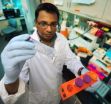(Press-News.org) Experts agree that, more than ever before, modern wars will be fought in the cyber zone, targeting an enemy's communications technology to cause untold damage. Now a Tel Aviv University researcher is suggesting that the same tactics should be employed in the battle against one of the body's deadliest enemies — cancer.
In an article published in Trends in Microbiology, Prof. Eshel Ben-Jacob of TAU's School of Physics and Astronomy and Prof. Herbert Levine of Rice University, long-time bacteria researchers, and Prof. Donald Coffey of Johns Hopkins University, a renowned cancer researcher, examine the shared traits of cancer cells and bacteria. Like bacteria, cancer cells rely on communication and "social networking" to become powerful entities within the body. Inspired by the social and survival tactics of bacteria, the team presents a new picture of cancer as a meta-community of smart communicating cells possessing special traits for cooperative behavior.
Knowing the enemy
For many years, scientists ignored the complex social interactions of bacteria, now the number three killer in hospitals in the Western world. The researchers believe that medical professionals are similarly "underestimating the enemy" when it comes to cancer cells that exhibit many similar behaviors.
The parallels that can be drawn between the two types of cells are astounding. While healthy cells are highly disciplined, responding to chemical and physical cues telling them how to behave, bacteria and cancer cells override this control by using different chemical and genetic pathways. They proliferate quickly to make rapid genetic changes, avoiding the body's immune system and developing drug resistance.
Using intricate communication, cancer cells can distribute tasks, share resources, differentiate, and make decisions. Before sending cells to colonize organs and tissues throughout the body (metastasis), "spying cells" explore the body and return the cancer's origin. Only then do metastatic cells leave the primary tumor and navigate to new posts.
Also like bacteria, cancer cells change their own environment. They induce genetic changes and enslave surrounding normal cells, forcing them to do the disease's bidding — providing physical support, protecting them from the immune system, and more. Cancer cells can also become dormant when they sense danger, such as chemotherapy chemicals, then reactivate at will.
A new therapeutic direction
Prof. Ben-Jacob suggests that studying the social behavior of cancer cells can inspire new research directions and pave the way for the development of novel therapeutic approaches — for example, a new class of drugs to target cell-to-cell communication or send misleading messages.
With the ability to become immune to chemotherapy and lay dormant until it determines the time is right to reawaken, cancer often relapses undetected until it's too late to treat, says Prof. Levine. Breaking the communication code for awakening dormant cells could help researchers learn how to reactivate them on purpose — and be ready to kill them as soon as they "awaken."
The team also suggests further research into cancer "cannibalism," when cancer cells may consume their peers when they run out of resources. The idea is to send signals which trigger cancer cells to kill each other, which can be done with bacteria.
Other researchers have demonstrated that injected bacteria can "outsmart cancer." Bacteria can be used to induce gap junctions between the cancer cells and immune cells, "teaching" the immune system to recognize and kill the tumor cells. We might be entering a new era of biological cyber-warfare, in which scientists can enlist bacterial intelligence to defeat cancer, Prof. Ben-Jacob concludes.
###
American Friends of Tel Aviv University supports Israel's leading, most comprehensive and most sought-after center of higher learning. Independently ranked 94th among the world's top universities for the impact of its research, TAU's innovations and discoveries are cited more often by the global scientific community than all but 10 other universities.
Internationally recognized for the scope and groundbreaking nature of its research and scholarship, Tel Aviv University consistently produces work with profound implications for the future.
END
AUGUSTA, Ga. – Connecting the dots between two molecules whose levels are decreased in depression and increased by current antidepressants could yield new therapies, researchers say.
Serotonin is a neurotransmitter that enables brain cells to communicate and brain-derived neurotropic factor, or BDNF, is a brain-nourishing molecule that also aids connectivity. Popular antidepressants such as Prozac, developed to increase levels of serotonin, have recently been found to also increase BDNF levels, said Dr. Anilkumar Pillai, neuroscientist at the Medical College of Georgia ...
New Rochelle, NY, August 14, 2012—Community pharmacies with specially trained staff to provide HIV services can help HIV-infected individuals be more compliant with their essential antiviral drug regimens and hence improve patient outcomes. Users of HIV-specialized Walgreen pharmacies across the U.S. had significantly greater adherence to and persistence with their therapeutic drug regimens according to a study published in AIDS Patient Care and STDs, a peer-reviewed journal from Mary Ann Liebert, Inc., publishers. The article is available free on the AIDS Patient Care ...
UPTON, NY - Scientists taking advantage of the versatility and new capabilities of the Relativistic Heavy Ion Collider (RHIC), an atom smasher at the U.S. Department of Energy's Brookhaven National Laboratory, have observed first glimpses of a possible boundary separating ordinary nuclear matter, composed of protons and neutrons, from the seething soup of their constituent quarks and gluons that permeated the early universe some 14 billion years ago. Though RHIC physicists have been creating and studying this primordial quark-gluon plasma (QGP) for some time, the latest ...
EAST LANSING, Mich. — Soil microbes are impulsive. So much so that they help plants face the challenges of a rapidly changing climate.
Jen Lau and Jay Lennon, Michigan State University biologists studied how plants and microbes work together to help plants survive the effects of global changes, such as increased atmospheric CO2 concentrations, warmer temperatures and altered precipitation patterns. The results, appearing in the current issue of the Proceedings of the National Academy of Sciences, showed that microbes in the ground not only interact with plants, but they ...
Researchers at Virginia Commonwealth University Massey Cancer Center are reporting promising results from laboratory and animal experiments involving a new combination therapy for multiple myeloma, the second most common form of blood cancer.
The study published online in the journal Cancer Research details a dramatic increase in multiple myeloma cell death caused by a combination of the drugs obatoclax and flavopiridol. The researchers, led by Steven Grant, M.D., Shirley Carter Olsson and Sture Gordon Olsson Chair in Oncology Research, associate director for translational ...
CAMBRIDGE, Mass. -- Tissue implants made of cells grown on a sponge-like scaffold have been shown in clinical trials to help heal arteries scarred by atherosclerosis and other vascular diseases. However, it has been unclear why some implants work better than others.
MIT researchers led by Elazer Edelman, the Thomas D. and Virginia W. Cabot Professor of Health Sciences and Technology, have now shown that implanted cells' therapeutic properties depend on their shape, which is determined by the type of scaffold on which they are grown. The work could allow scientists to ...
WASHINGTON, Aug. 14, 2012-- To warn of chemical attacks and help save lives, it's vital to quickly determine if even trace levels of potentially deadly chemicals—such as the nerve gas sarin and other odorless, colorless agents—are present. U.S. Army researchers have developed a new chemical sensor that can simultaneously identify a potentially limitless numbers of agents, in real time. A paper describing the system has been published today in the Optical Society's (OSA) journal, Optics Letters.
The new system is based on a phenomenon known as the photoacoustic effect, ...
URBANA – A new discovery should make the alternative fuel butanol more attractive to the biofuel industry. University of Illinois scientist Hao Feng has found a way around the bottleneck that has frustrated producers in the past and could significantly reduce the cost of the energy involved in making it as well.
"The first challenge in butanol production is that at a certain concentration the fuel being created becomes toxic to the organism used to make it (Clostridium pasteurianum and other strains), and that toxicity limits the amount of fuel that can be made in one ...
BOZEMAN, Mont. – A female moth sitting on a goal post could attract a male moth on the other end of a football field. And even if she switched her scent over time, the male could still find her because of a mutation to a single gene in his antenna.
A team of researchers led by Montana State University entomologist Kevin Wanner identified that gene after seeing how it adapted to even the slightest change in the chemicals female moths emit to attract males. The scientists explained their findings in the Aug. 13 online edition of the Proceedings of the National Academy of ...
Facing looming policy uncertainty beyond 2012, the U.S. remained one of the fastest-growing wind power markets in the world in 2011—second only to China—according to a new report released by the U.S. Department of Energy and prepared by Lawrence Berkeley National Laboratory (Berkeley Lab). Roughly 6.8 gigawatts (GW) of new wind power capacity were connected to the U.S. grid in 2011—more than the 5.2 GW built in 2010, but below the 10 GW added in 2009. Driven by the threat of expiring federal incentives, new wind power installations are widely expected to be substantially ...



